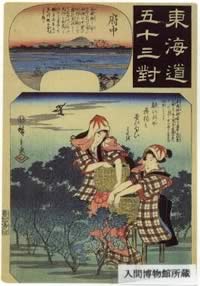Ordinary people begun to enjoy the Japanese
green tea from Edo period.Also Tea production has developed in great advance in
edo period.According to the edo-period's tea book "Honcho-shoku-kan"("Japan's
food dictionary" 1697 Author Hitomi Hitsudai ) , In the middle of edo period,
Maccha's production area is only uji but Sencha produced in various places. (Note:
this Sencha is different from the present sencha).
It was written that the teas sold in Edo(Tokyo) were produced in Sunsyu(Sizuoka
prefecture), Sinsyu(Nagano prefecture), Yasyuu(Saitama prefecture) and Osyu (Touhoku
prefecture).It means that for example in the case of Edo and production areas
, the production relationship begun to be exits. (Note: this Sencha is different
from the present sencha.)
Also It was written in "Honcho-shoku-kan" that "Recently people
drink decocted tea before breakfast in Koto( alongside of Sumida river of Tokyo),
especially women drink the teas". |
| Sencha diffused many places and tea
was spread at nation wide and ordinary people can drink teas. As Sencha begun
to produce, the founder of the Sencha-do appeared. He is called "Baichao".
He is a priest. When Baichao studied in Nagasaki, he found Sencha and he lived
in among Sencha.In the beginning ,"he serve tea to visitors in places where
water or stone is clean.He did not discriminate by people's social position and
did not stuck on the money. He told social events peacefully, everybody became
familiar with him"(From Honcho-shoku-kan) When he was 57 years old he went
to Kyoto and open a tea shop that is called Tsusentei.He walk and sell the tea
all around Kyoto and outside Kyoto also, alongside of pond of the Daibutsu(great
image of Buddha), Tofuku temple and Momiji-Yama, and Saga.
He became famous.Baichaou notice Sencha in his seeking after truth. Sencha
may have new attractiveness for him.At the same time there is a breakthrough in
the Japanese green tea. Souen Nagatani , Farmer in Kyoto, invented steaming method
Sencha that is new distinguished high quality tea.Until then, it is said that
sencha is made by using new and old leaves and hard buds and by boiling as well
as using the iron pot.
Souen Nagatani used fresh new leaves and steamed them and rubbed and dried
them on the hoiro(device that tea are heat on the top of it) and made tea whose
color is green and its aroma is good.Souen said ,in short, Sencha's quality is
determined by steaming , rubbing, drying.
Tea before the new teas were produced, the tea's color is brown, and the new
tea's color is fresh green so that the new tea was called "Aosei"(Blue
method) In contrast the before tea was called "Kurosei"(Black method).Souen
ask Edo tea merchant to sell the tea and the tea had a great reputation. Baichaou
visited Souen and Baoichaou drank the tea.
|
| For the invention of the steaming method produced
tea, it is certain that there was development of Japanese agriculture.Although
it is a partly, but tea production became an independent sector. The Baichaou's
Sencha-do may be influenced by the steaming method produced tea.Here is a very
healthy culture that is based on production
How ordinary people drank teas? According to late edo period's scholar of Japanese
classical literature, Natsukage Maeda's book "Konome-setsu","Nowadays
even any poor house's people boiling teas and drink teas every day from morning
and evening, every time." Here is a proof that anybody anytime enjoyed the
teas. |
|
 |

